Related Research Articles
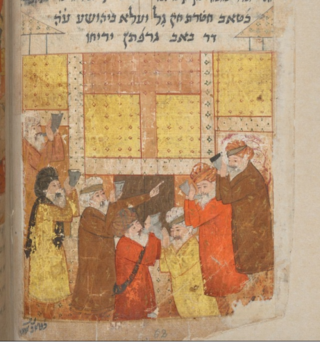
Judeo-Persian refers to both a group of Jewish dialects spoken by the Jews living in Iran and Judeo-Persian texts. As a collective term, Judeo-Persian refers to a number of Judeo-Iranian languages spoken by Jewish communities throughout the formerly extensive Persian Empire, including the Mountain and Bukharan Jewish communities.
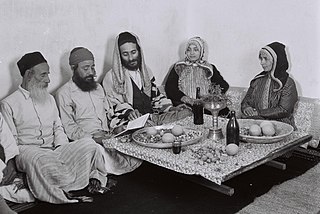
Yemenite Jews, also known as Yemeni Jews or Teimanim, are those Jews who live, or once lived, in Yemen, and their descendants maintaining their customs. Between June 1949 and September 1950, the overwhelming majority of the country's Jewish population immigrated to Israel in Operation Magic Carpet. After several waves of persecution, the vast majority of Yemenite Jews now live in Israel, while smaller communities live in the United States and elsewhere. As of 2022, only one Jew remained in Yemen.

Jewish languages are the various languages and dialects that developed in Jewish communities in the diaspora. The original Jewish language is Hebrew, supplanted as the primary vernacular by Aramaic following the Babylonian exile. Jewish languages feature a syncretism of Hebrew and Judeo-Aramaic with the languages of the local non-Jewish population.

Judeo-Arabic dialects are ethnolects formerly spoken by Jews throughout the Arabic-speaking world. Under the ISO 639 international standard for language codes, Judeo-Arabic is classified as a macrolanguage under the code jrb, encompassing four languages: Judeo-Moroccan Arabic (aju), Judeo-Yemeni Arabic (jye), Judeo-Iraqi Arabic (yhd), and Judeo-Tripolitanian Arabic (yud).
Mizrahi Jews, also known as Mizrahim (מִזְרָחִים) or Mizrachi (מִזְרָחִי) and alternatively referred to as Oriental Jews or Edot HaMizrach, are a grouping of Jewish communities comprising those who remained in the Land of Israel and those who existed in diaspora throughout and around the Middle East and North Africa (MENA) from biblical times into the modern era.

Judeo-Berber or Judeo-Amazigh is any of several hybrid Berber varieties traditionally spoken as a second language in Berber Jewish communities of central and southern Morocco, and perhaps earlier in Algeria. Judeo-Berber is a contact language; the first language of speakers was Judeo-Arabic. Speakers immigrated to Israel in the 1950s and 1960s. While mutually comprehensible with the Tamazight spoken by most inhabitants of the area, these varieties are distinguished by the use of Hebrew loanwords and the pronunciation of š as s.
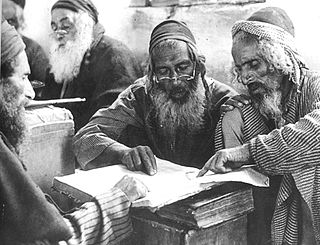
Yemenite Hebrew, also referred to as Temani Hebrew, is the pronunciation system for Hebrew traditionally used by Yemenite Jews. Yemenite Hebrew has been studied by language scholars, many of whom believe it to retain older phonetic and grammatical features lost elsewhere. Yemenite speakers of Hebrew have garnered considerable praise from language purists because of their use of grammatical features from classical Hebrew. Tunisian rabbi and scholar, Rabbi Meir Mazuz, once said of Yemenites that they are good grammarians.

Judeo-Tat or Juhuri is a traditional language of the Mountain Jews, primarily spoken in Azerbaijan, Dagestan, and Israel.

Bukharian is a Judeo-Persian dialect historically spoken by the Bukharan Jews of Central Asia. It is a Jewish dialect derived from — and largely mutually intelligible with — the Tajik branch of the Persian language.

Judeo-Malayalam is the traditional language of the Cochin Jews, from Kerala, in southern India, spoken today by a few dozens of people in Israel and by probably fewer than 25 in India.
Judaeo-Romance languages are Jewish languages derived from Romance languages, spoken by various Jewish communities originating in regions where Romance languages predominate, and altered to such an extent to gain recognition as languages in their own right. The status of many Judaeo-Romance languages is controversial as, despite manuscripts preserving transcriptions of Romance languages using the Hebrew alphabet, there is often little-to-no evidence that these "dialects" were actually spoken by Jews living in the various European nations.
Baghdad Jewish Arabic or autonymhaki mal yihud or el-haki malna is the variety of Arabic spoken by the Jews of Baghdad and other towns of Lower Mesopotamia in Iraq. This dialect differs from the North Mesopotamian Arabic spoken by Jews in Upper Mesopotamian cities such as Mosul and Anah. Baghdadi and Northern Mesopotamian are subvarieties of Judeo-Iraqi Arabic.

Shalom Shabazi was the son of Yosef ben Avigad, of the family of Mashtā, also commonly known as Abba Sholem Shabazi or Saalem al-Shabazi. He was a Jewish poet who lived in 17th century Yemen, often referred to as the arch-poet of Yemen.
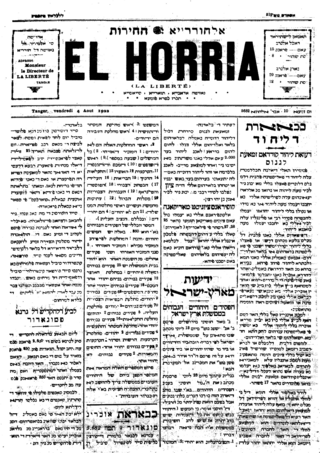
Judeo-Moroccan Arabic is the variety or the varieties of the Moroccan vernacular Arabic spoken by Jews living or formerly living in Morocco. Historically, the majority of Moroccan Jews spoke Moroccan vernacular Arabic, or Darija, as their first language, even in Amazigh areas, which was facilitated by their literacy in Hebrew script. The Darija spoken by Moroccan Jews, which they referred to as al-‘arabiya diyalna as opposed to ‘arabiya diyal l-məslimīn, typically had distinct features, such as š>s and ž>z "lisping," some lexical borrowings from Hebrew, and in some regions Hispanic features from the migration of Sephardi Jews following the Alhambra Decree. The Jewish dialects of Darija spoken in different parts of Morocco had more in common with the local Moroccan Arabic dialects than they did with each other.
Judeo-Iraqi Arabic, also known as Iraqi Judeo-Arabic and Yahudic, is a variety of Arabic spoken by Iraqi Jews currently or formerly living in Iraq. It is estimated that there are 94,000 speakers in Israel and that just 120 older speakers remain in Iraq. The best known variety is Baghdad Jewish Arabic, although there were different dialects in Mosul and elsewhere.
Judeo-Tripolitanian Arabic is a variety of Arabic spoken by Jews formerly living in Libya.
Judeo-Tunisian Arabic, also known as Judeo-Tunisian, is a variety of Tunisian Arabic mainly spoken by Jews living or formerly living in Tunisia. Speakers are older adults, and the younger generation has only a passive knowledge of the language.
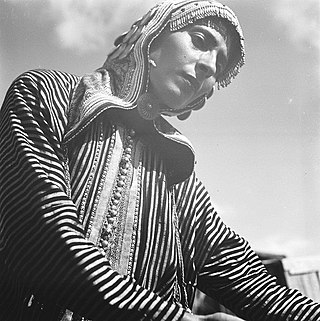
Yemenite Jews in Israel are immigrants and descendants of the immigrants of the Yemenite Jewish communities, who now reside within the state of Israel. They number around 400,000 in the wider definition. Between June 1949 and September 1950, the overwhelming majority of Yemen and Aden's Jewish population was transported to Israel in Operation Magic Carpet.
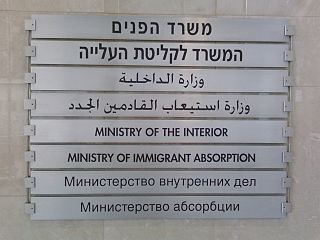
The Arabic language in Israel is spoken natively by over 20 percent of the Israeli population, predominantly by Israeli Arabs, but also by Jews who arrived in Israel from Arab countries. Some refer to the modern Hebrew-influenced Levantine Arabic vernacular as the "Israeli Arabic dialect" or colloquially as Aravrit, a portmanteau of the Hebrew words Ivrit and Aravit.
Yemenite Jewish poetry, often referred to as "paraliturgical poetry" because of its religious nature, has been an integral part of Yemenite Jewish culture since time immemorial. The Jews of Yemen have preserved a well-defined singing arrangement which not only includes the very poetic creation itself, but also involves a vocal and dance performance, accompanied in certain villages outside Sana'a by drumming on an empty tin-can (tanakeh) or a copper tray. The Jews of Yemen, maintaining strict adherence to Talmudic and Maimonidean halakha, observed the gezeirah which prohibited playing musical instruments, and "instead of developing the playing of musical instruments, they perfected singing and rhythm." This arrangement was integrated into the walks of life familiar to the Jews of Yemen. The texts used in the arrangement were put down in writing and later included in separate song collections (dīwāns). The social strictures and norms in Yemenite Jewish culture provide for separate settings for men and for women, where the sexes are never mixed. Men’s song usually expressed the national aspirations of the Jewish people, and it was far removed from the singing associated with the Muslim environment, whereas folk songs of Jewish women were sung by rote memory and expressed the happiness and sorrows inherent in their daily life and was, as a rule, closer to that of Muslim women.
References
- ↑ Judeo-Yemeni Arabic at Ethnologue (25th ed., 2022)

- 1 2 Judeo-Yemeni Arabic at Ethnologue (18th ed., 2015) (subscription required)
- ↑ Berer, Josh (2010-01-06). "Caught in Strife, Yemen's Jews Cling Fiercely to Their Ancient Heritage". Forward. Retrieved 2016-12-10.
- ↑ "History of the Jews of Yemen". May 10, 2022.